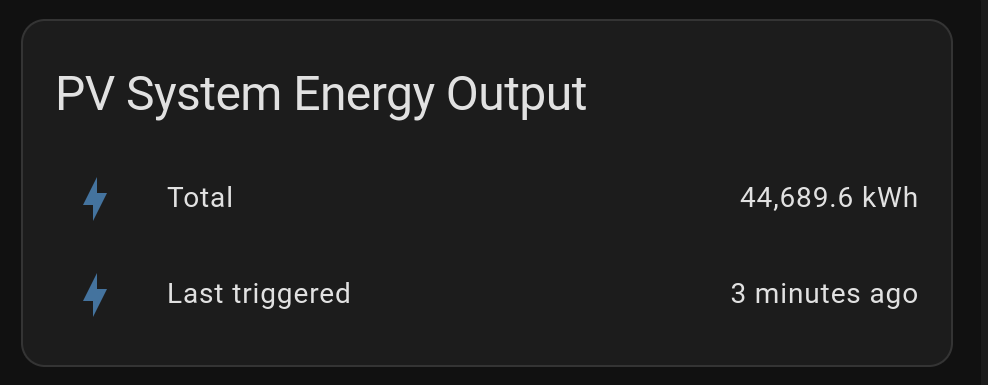Do you have a sensor that is regularly unavailable on your Home Assistant Dashboard, but you’d like to see what the last measured value was?
Here is how to retain the value.
TL;DR
- Create a template sensor.
- Update the template sensor’s value with a trigger.
- Add an entities card to your dashboard for the new template sensor.
Worked example
Let’s look at a worked example for a PV inverter. This inverter has an energy meter that measures the total energy produced by the inverter over it’s lifetime. However, at night time the inverter switches off and the sensor value becomes unavailable.
Create a template sensor
We create a new template sensor with the line template:.
Next, setup a trigger:. This updates the template sensor everytime the state of the PV Inverter’s sensor is updated, but specifically excludes the states unknown and unavailable. Also note that there is no trigger for platform: homeassistant event: start, so the value does not change when home assistant is started.
The template sensor’s state (i.e. value) is derived from the state of sensor.pv_inverter_energy_total (i.e. value of the PV inverter’s sensor). The JINJA templating expression is {{ trigger.to_state.state }}.
The template sensor’s secondary_info last_changed is updated when home assistant is started. So we will create our own attribute last_triggered to retain the value after a reboot. You may have noticed that only Automations and Scripts1 have last-triggered in their secondary_info, we’ll mimic this data as an attribute. We return a string of date, time, and UTC offset to the corresponding time zone in the ISO 8601 format.
# This sensor should hold it's value until the next time the state is available
---
template:
trigger:
- platform: state
entity_id: sensor.pv_inverter_energy_total
not_to:
- 'unknown'
- 'unavailable'
sensor:
- name: pv_system_energy_output_total_persistent
device_class: energy
state_class: total_increasing
unit_of_measurement: kWh
state: >-
{{ trigger.to_state.state }}
attributes:
last_triggered: >-
{{ (trigger.to_state.last_changed|as_local).isoformat() }}Add an Entities card to your dashboard
Through the UI add an entities card for our new sensor. The entity can be added through the UI but not the attribute. Click SHOW CODE EDITOR to see the yaml configuration.
type: entities
title: PV System Energy Output
entities:
- entity: sensor.pv_system_energy_output_total_persistent
name: Total
- type: attribute
entity: sensor.pv_system_energy_output_total_persistent
attribute: last_triggered
format: relative
name: Last triggered

Did you notice that the last_triggered attribute was automatically converted from ISO 8601 format to a relative format: “3 minutes ago”.
Conclusion
I hope this helps you make your dashboards more usable.
Other example sensors where this solution could be used:
- A level sensor on a remote tank that updates it’s level infrequently because the water level is not changing or the device is sleeping to reduce battery consumption.
Please feel welcome to leave a comment below.
Footnotes
-
“As of Home Assistant Core 2024.8, only Automations and Scripts have
last-triggeredin their secondary_info.” ↩